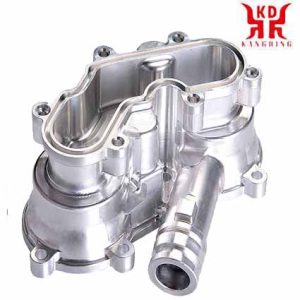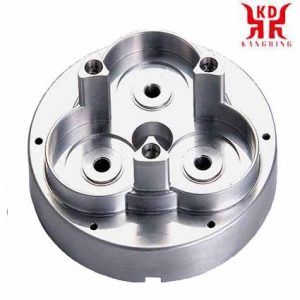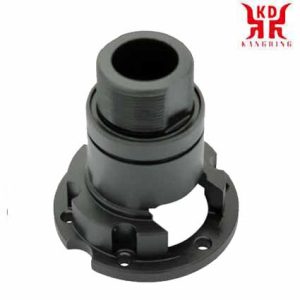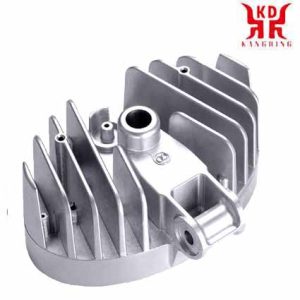இந்த கட்டுரையில் எந்திர செயல்முறைகளைப் பற்றி விவாதிப்போம் (திருப்புதல், அரைத்தல், முடித்தல்), கருவிகள், CNC எந்திர அலுமினியம் மற்றும் அலுமினிய கலவைகளில் உள்ள அளவுருக்கள் மற்றும் சவால்கள். அலுமினியம் மற்றும் CNC எந்திரத்தில் பொதுவாகப் பயன்படுத்தப்படும் உலோகக் கலவைகளின் பண்புகளையும் நாங்கள் பகுப்பாய்வு செய்கிறோம், அத்துடன் பல்வேறு தொழில்துறை துறைகளில் அவற்றின் பயன்பாடு பகுதிகள்.

அலுமினிய அலாய் பாகங்களின் விரைவான முன்மாதிரி
நீங்கள் CNC இயந்திர அலுமினியத்தில் ஆர்வமாக இருந்தால், உங்கள் பகுதிகளுக்கான மேற்கோளை இங்கே கோரலாம்.
அலுமினியம் இன்று மிகவும் பரவலாகப் பயன்படுத்தப்படும் பொருட்களில் ஒன்றாகும். உண்மையாக, CNC எந்திரத்தில் பயன்படுத்தப்படும் அதிர்வெண் அடிப்படையில் அலுமினியம் எஃகு மூலம் மட்டுமே மிஞ்சியுள்ளது. இது முக்கியமாக அலுமினியத்தின் சிறந்த இயந்திரத்திறன் காரணமாகும்.
அதன் தூய வடிவத்தில், வேதியியல் உறுப்பு அலுமினியம் மென்மையானது, இணக்கமான, காந்தமற்றது மற்றும் வெள்ளி-வெள்ளை தோற்றம் கொண்டது. எனினும், அலுமினியம் தனிமம் அதன் தூய வடிவில் மட்டும் பயன்படுத்தப்படவில்லை. அலுமினியம் பொதுவாக மாங்கனீசு போன்ற பல்வேறு தனிமங்களுடன் இணைந்து பயன்படுத்தப்படுகிறது, தாமிரம் மற்றும் மெக்னீசியம் நூற்றுக்கணக்கான அலுமினிய கலவைகளை பல்வேறு வகைகளுடன் தயாரிக்கிறது, கணிசமாக மேம்படுத்தப்பட்ட பண்புகள். மிகவும் பொதுவான அலுமினிய உலோகக்கலவைகள் மற்றும் பல்வேறு தரநிலைகளில் அவற்றின் பெயர்கள் இங்கே காணலாம்.
படம் 1: Pure aluminum
Benefits of using aluminum for CNC machined components
Although there are many different aluminum alloys with different properties, all aluminum alloys have the same essential properties.
Machinability
Aluminum can be shaped and machined using a variety of different methods. It can be cut quickly and easily with the help of processing machines because it is soft and has high machinability. It is also cheaper than steel and requires less machining. These properties are of great benefit to the cutting machine operator and the customer. கூடுதலாக, aluminum is less deformed during machining due to its high machinability. This leads to higher accuracy, as CNC machines can achieve higher tolerances.
Strength to weight ratio
The density of aluminum is about a third of the density of steel. எனவே அலுமினியம் ஒப்பீட்டளவில் லேசானது. அதன் குறைந்த எடை இருந்தபோதிலும், அலுமினியம் மிகவும் வலுவானது. அதிக வலிமை மற்றும் குறைந்த எடை ஆகியவற்றின் கலவையானது வலிமை-எடை விகிதத்தால் விவரிக்கப்படுகிறது. அதன் அதிக வலிமை-எடை விகிதம் அலுமினியத்தை பல்வேறு தொழில்துறை துறைகளில் உள்ள கூறுகளுக்கு ஒரு சாதகமான பொருளாக ஆக்குகிறது., வாகன மற்றும் விண்வெளித் தொழில்கள் போன்றவை.
அரிப்பு எதிர்ப்பு
வழக்கமான கடல் மற்றும் வளிமண்டல நிலைமைகளின் கீழ் அலுமினியம் கீறல் மற்றும் அரிப்பை எதிர்க்கும். இந்த பண்புகளை அனோடைசிங் மூலம் மேம்படுத்தலாம். இது குறிப்பிடத்தக்கது, எனினும், அலுமினியத்தின் வகையைப் பொறுத்து அரிப்பு எதிர்ப்பு மாறுபடும். எனினும், CNC எந்திரத்தில் பயன்படுத்தப்படும் அலுமினியத்தின் மிகவும் பொதுவான வகைகள் அதிக எதிர்ப்பைக் கொண்டுள்ளன.
குறைந்த வெப்பநிலையில் நடத்தை
பெரும்பாலான பொருட்கள் பூஜ்ஜியத்திற்கும் குறைவான வெப்பநிலையில் அவற்றின் நன்மை பயக்கும் பண்புகளை இழக்கின்றன. உதாரணத்திற்கு, கார்பன் எஃகு மற்றும் ரப்பர் இரண்டும் குறைந்த வெப்பநிலையில் உடையக்கூடியதாக மாறும். மாறாக, அலுமினியம் மென்மையாக இருக்கும், மிகவும் குறைந்த வெப்பநிலையில் கூட இணக்கமான மற்றும் வலுவான.
மின் கடத்துத்திறன்
அறை வெப்பநிலையில் தூய அலுமினியத்தின் மின் கடத்துத்திறன் 36.7 ஒரு மீட்டருக்கு மில்லியன் சீமென்ஸ். அலுமினிய கலவைகள் தூய அலுமினியத்தை விட குறைந்த கடத்துத்திறனைக் கொண்டிருக்கும், அவை மின் கூறுகளாகப் பயன்படுத்தக்கூடிய அளவுக்கு கடத்தும் தன்மை கொண்டவை. மறுபுறம், உற்பத்தி செய்யப்பட்ட கூறுகளின் அதிக மின் கடத்துத்திறன் விரும்பத்தகாததாக இருந்தால் அலுமினியம் பொருத்தமற்றது.
மறுசுழற்சி
CNC எந்திரம் ஒரு கழித்தல் உற்பத்தி செயல்முறை என்பதால், எந்திரத்தின் போது நிறைய சில்லுகள் மற்றும் அதனால் நிறைய பொருள் கழிவுகள் ஏற்படுகின்றன. அலுமினியம் மறுசுழற்சிக்கு மிகவும் பொருத்தமானது, அதாவது. ஒப்பீட்டளவில் சிறிய ஆற்றல், அலுமினியத்தை மறுசுழற்சி செய்ய முயற்சி மற்றும் செலவுகள் தேவை. இது பொருள் விரயத்தைத் தவிர்க்கும் வகையில் இது ஒரு சாதகமான பொருளாக அமைகிறது. இது அலுமினியத்தை CNC எந்திரத்தில் சுற்றுச்சூழலுக்கு உகந்த பொருளாக ஆக்குகிறது.
அனோடைசிங்
அனோடைசிங் செயல்முறை என்பது மேற்பரப்பு முடித்த செயல்முறையாகும், இது ஒரு பொருளின் உடைகள் எதிர்ப்பு மற்றும் அரிப்பு எதிர்ப்பை மேம்படுத்துகிறது. அலுமினியம் அனோடைசிங் செயல்முறைக்கு ஏற்றது. இந்த செயல்முறை தயாரிக்கப்பட்ட அலுமினிய கூறுகளை வண்ணமயமாக்குவதை எளிதாக்குகிறது.

அலுமினிய பாகங்களின் CNC துருவல்
CNC எந்திரத்திற்கான பிரபலமான அலுமினிய கலவைகள்
எங்கள் அனுபவத்தில், பின்வரும் 5 அலுமினிய வகைகள் பொதுவாக CNC இயந்திரத்தில் பயன்படுத்தப்படுகின்றன.
மற்றும் AW 2007
மாற்று பெயர்கள்: 3.1645; IN 573-3; AlCu4PbMgMn.
இந்த அலுமினிய கலவையில் தாமிரத்தை முக்கிய கலப்பு உறுப்பு உள்ளது (4-5% செம்பு). இது ஒரு குறுகிய சில்லு கலவையாகும், இது லேசானது, நீடித்தது, மிகவும் செயல்பாட்டு மற்றும் AW போன்ற அதே இயந்திர பண்புகளை கொண்டுள்ளது 2030. இது நூல் வெட்டுவதற்கும் ஏற்றது, heat treatment and high speed machining. All these properties make EN AW 2007 a widely used material in the manufacture of components, போல்ட், திருகுகள், nuts, rivets and threaded rods. எனினும், this type of aluminum has poor weldability and corrosion resistance; It is therefore advisable to use protective anodizing after the component has been manufactured.
மற்றும் AW 5083
மாற்று பெயர்கள்: 3.3547; Alloy 5083; IN 573-3; UNS A95083; ASTM B209; AlMg4.5Mn0.7
AW 5083 is known for its excellent performance in harsh conditions. It contains magnesium and traces of chromium and manganese. This variety has a very high resistance to corrosion in chemical and marine environments. AW 5080 has the highest strength of all non-heat-treatable alloys; a property that it receives even after welding. While this alloy should not be used for applications with temperatures above 65 ° C, it has excellent performance in low temperature applications.
Because of its range of beneficial properties, AW 5080 is used for a wide variety of applications including cryogenic systems, marine applications, pressure systems, chemical applications, welded structures and vehicle bodies.

Surface finishing of aluminum alloy parts
மற்றும் AW 5754
மாற்று பெயர்கள்: 3.3535; Alloy 5754; IN 573-3; U21NS A95754; ASTM B 209; Al-Mg3.
As an aluminum-magnesium kneading material with the highest percentage of aluminum, AW 5754 can be rolled, forged and extruded. It is not heat treatable and can be cold worked to increase strength at the expense of formability. கூடுதலாக, this alloy is excellent in corrosion resistance and has high strength. With these properties, it is not surprising that AW 5754 is one of the most widely used types of aluminum in CNC machining. It is commonly used in welded structures, floors, fishing gear, vehicle bodies, rivets, and in food processing.
மற்றும் AW 6061
மாற்று பெயர்கள்: 3.3206; ஐஎஸ்ஓ 6361; UNS A96060; ASTM B 221; AlMgSi0.5
This is a wrought alloy containing magnesium and silicon. It is heat treatable and has average strength, good weldability and good formability. கூடுதலாக, it has a very high corrosion resistance; a property that can be improved by anodizing. மற்றும் AW 6060 is widely used in construction, food processing, medical technology and automotive technology.
மற்றும் AW 7075
மாற்று பெயர்கள்: 3.4365; UNS A96082; H30; Al-Zn6MgCu.
The main alloying element of this type of aluminum is zinc. Although EN AW 7075 has average machinability, poor cold forming properties and is unsuitable for welding or brazing, it has a high strength-to-weight ratio, excellent resistance to atmospheric and marine environments, and strength comparable to some steel alloys. This alloy is used in a very wide range of applications – from hang gliders, bicycle frames, climbing equipment and weapons to the construction of manufacturing tools.

Turned parts of aluminum alloy
CNC machining process for aluminum
Aluminum can be machined using many of the CNC processes available today. We have listed some of these procedures:
திருப்புதல்
In CNC machining processes, the workpiece rotates while the single-point cutting tool remains stationary along its axis. Depending on the machine used, either the workpiece or the cutting tool performs a feed movement in order to remove the material.
Find out more about our CNC turning services.
துருவல்
Milling processes are the most frequently used methods when machining aluminum components. These methods consist of rotating a multipoint cutting tool along its axis while the workpiece remains stationary along its own axis. The cutting action and subsequent material removal is achieved by a feed movement of the workpiece or the cutting tool, or a combination of both. This movement can take place along several axes.
Find out more about our CNC milling services.
Pocket milling
Pocket milling, also known as pocketing, is a CNC milling method in which a hollow pocket is milled into a component.

CNC machining of aluminum alloy parts
Face turning and face milling
In machine processing, facing / milling is the creation of a flat cross-sectional area on the surface of a workpiece by turning / அரைத்தல்.
Drilling
Drilling is the process of creating a hole in a workpiece. இந்த செயல்பாட்டில், a multi-point rotating cutting tool of a certain size moves in a straight line, perpendicular to the surface to be machined, effectively creating a hole.
Tools for aluminum processing
Many different factors play a role when selecting tools for CNC machining.
Tool design
Different geometry aspects of a tool contribute to the effectiveness in terms of aluminum machining. One of them is the number of cutting edges. In order to avoid difficulties in removing chips at high speeds, the cutting tools for aluminum CNC machining should have 2-3 cutting edges. A higher number of cutting edges leads to smaller chip bays. This causes the large chips of the aluminum alloys to get stuck. When cutting forces are low and chip evacuation is a major concern of the process, two cutting edges should be used. Three cutting edges can be used for the perfect balance between chip evacuation and tool strength.
Helix angle
The helix angle is the angle between the centerline of a tool and a straight tangent line along the cutting edge. While a high helix angle removes chips quickly, this also increases friction and heat generation during machining. This can cause chips to weld to the tool surface during high speed CNC machining of aluminum. A smaller helix angle results in less heat generation, but it may not be able to effectively remove the chips. When machining aluminum, a bevel angle of 35 ° or 40 ° is suitable for rough applications, while an angle of 45 ° is suitable for finishing work.
Clearance angle
The clearance angle is another important factor for the proper function of a tool. An excessively large angle would cause the tool to dig into the component and rattle back and forth. மறுபுறம், angles that are too small can lead to high friction between the tool and the workpiece. Clearance angles between 6 ° and 10 ° are particularly suitable for CNC machining of aluminum.

Aluminum die casting
Tool material
Tungsten carbide is the preferred material for cutting tools used in CNC aluminum machining. Since aluminum is very soft and easy to cut, the decisive factor in a cutting tool for aluminum is not the hardness, but the ability to obtain a razor-sharp edge. This ability is present in cemented carbide tools and depends on two factors, the cemented carbide grain size and the proportion of binder. While a larger grain size results in a harder material, a smaller grain size guarantees a tougher, more impact-resistant material that is exactly the property we need. சிறிய தானியங்களுக்கு மெல்லிய தானிய அமைப்பு மற்றும் பொருளின் வலிமையை அடைய கோபால்ட் தேவைப்படுகிறது.
எனினும், கோபால்ட் அதிக வெப்பநிலையில் அலுமினியத்துடன் வினைபுரிந்து கருவியின் மேற்பரப்பில் அலுமினியத்தால் ஆன ஒரு உள்ளமைக்கப்பட்ட விளிம்பை உருவாக்குகிறது.. முக்கிய விஷயம் என்னவென்றால், சரியான அளவு கோபால்ட் கொண்ட சிமென்ட் செய்யப்பட்ட கார்பைடு கருவியைப் பயன்படுத்த வேண்டும் (2-20%) தேவையான வலிமையை பராமரிக்கும் போது இந்த எதிர்வினை குறைக்க. டங்ஸ்டன் கார்பைடு கருவிகள் பொதுவாக எஃகு கருவிகளை விட CNC அலுமினிய இயந்திரத்தின் அதிவேகத்தை தாங்குவதற்கு மிகவும் பொருத்தமானது.. கருவி பொருள் கூடுதலாக, கருவியின் பூச்சு கருவியின் வெட்டு செயல்திறனில் ஒரு முக்கிய காரணியாகும்.
ZrN (சிர்கோனியம் நைட்ரைடு), TiB2 (டைட்டானியம் போரைடு) மற்றும் வைரம் போன்ற பூச்சுகள் அலுமினியத்தின் CNC எந்திரத்திற்கான பொருத்தமான கருவி பூச்சுகளில் சில..
ஊட்டங்கள் மற்றும் வேகம்
வெட்டும் வேகம் என்பது வெட்டும் கருவி சுழலும் வேகம். அலுமினியம் மிக அதிக வெட்டு வேகத்தை தாங்கும் என்பதால், அலுமினிய உலோகக்கலவைகளுக்கான வெட்டு வேகம் பயன்படுத்தப்படும் இயந்திரத்தின் பயன்பாட்டு வரம்புகளைப் பொறுத்தது. CNC அலுமினியம் எந்திரம் போல, வேகம் முடிந்தவரை அதிகமாக இருக்க வேண்டும், இது கட்டப்பட்ட விளிம்புகளின் அபாயத்தைக் குறைக்கிறது, நேரத்தை மிச்சப்படுத்துகிறது, கூறுகளின் வெப்பநிலை உயர்வைக் குறைக்கிறது, சிப் உடைப்பதை மேம்படுத்துகிறது மற்றும் மேற்பரப்பை மேம்படுத்துகிறது. சரியான வேலை வேகம் அலுமினிய கலவை மற்றும் கருவி விட்டம் சார்ந்துள்ளது.
ஊட்டம் என்பது ஒரு கருவியின் சுழற்சிக்கு ஒர்க்பீஸ் அல்லது கருவி நகர்த்தப்படும் தூரம் ஆகும். பயன்படுத்தப்படும் தீவன விகிதம் விரும்பிய மேற்பரப்பு முடிவைப் பொறுத்தது, பணிப்பகுதியின் வலிமை மற்றும் விறைப்பு. கரடுமுரடான வெட்டுக்களுக்கு ஒரு தீவனம் தேவைப்படுகிறது 0.15 செய்ய 2.03 மிமீ / rev, செயல்பாடுகளை முடிக்கும்போது ஒரு ஊட்டம் தேவைப்படுகிறது 0.05 செய்ய 0.15 மிமீ / rev.
குளிரூட்டும் மசகு எண்ணெய்
Despite its good machinability, aluminum should never be cut dry as this promotes the formation of built-up edges. Suitable cooling lubricants for aluminum CNC machining are soluble oil emulsions and mineral oils. Avoid cooling lubricants that contain chlorine or active sulfur, as these elements pickle aluminum. You can find out more about cooling lubricants here.

CNC machining aluminum alloy cavity
Post-processing processes
After machining an aluminum part, there are certain processes that can be carried out to improve the physical, mechanical and aesthetic properties of the part. The most common methods are listed below.
Pearl blasting – compressed air blasting with solid abrasive
Bead blasting is a finishing process for aesthetic purposes. இந்த செயல்பாட்டில், the manufactured component is blasted with a strong jet of compressed air and tiny glass beads, which effectively removes the material and ensures a smooth surface. It gives aluminum a satin or matt surface. The most important process parameters for bead blasting are the size of the glass beads and the strength of the air pressure used. Use this procedure only when the dimensional tolerances of the part are not critical.
Other finishing processes are polishing and painting.
Coating
இந்த செயல்பாட்டில், the aluminum workpiece is coated with another material, for example zinc, nickel or chromium. This is done to improve the functionality of the component and can be achieved through electrochemical processes.
அனோடைசிங்
அனோடைசிங் செயல்முறை என்பது ஒரு மின்வேதியியல் செயல்முறையாகும், இதில் அலுமினிய வேலைப்பாடு சல்பூரிக் அமிலத்தின் கரைசலில் வைக்கப்படுகிறது.. அனோட் மற்றும் கேத்தோடிற்கு இடையில் ஒரு மின்னழுத்தம் பயன்படுத்தப்படுகிறது. இந்த செயல்முறை வேலைப்பொருளின் வெளிப்படும் மேற்பரப்புகளை மின்சாரம் அல்லாத எதிர்வினை அலுமினிய ஆக்சைடு பூச்சாக மாற்றுகிறது.. பூச்சுகளின் அடர்த்தி மற்றும் தடிமன் கரைசலின் கலவையைப் பொறுத்தது, அனோடைசிங் செயல்முறையின் காலம் மற்றும் மின்சாரம் பயன்படுத்தப்படுகிறது. கூறுகளை வண்ணமயமாக்க அனோடைசிங் பயன்படுத்தப்படலாம்.

அலுமினிய சுயவிவரம்
பவுடர் பூச்சு
தூள் பூச்சு செயல்பாட்டில், மின்னியல் ஸ்ப்ரே துப்பாக்கியைப் பயன்படுத்தி வண்ண பாலிமர் தூள் மூலம் கூறு பூசப்பட்டுள்ளது. பகுதி பின்னர் ஒரு வெப்பநிலையில் குணப்படுத்தப்படுகிறது 200 ° C. தூள் பூச்சு வலிமை மற்றும் அணிய எதிர்ப்பு அதிகரிக்கிறது, அரிப்பு மற்றும் தாக்கம்.
வெப்ப சிகிச்சை
Components made from heat-treatable aluminum alloys can be subjected to a heat treatment to improve their mechanical properties.
Applications of CNC-manufactured aluminum components in industry
மேலே குறிப்பிட்டுள்ளபடி, aluminum alloys have a number of advantageous properties. This is why CNC-manufactured aluminum components are indispensable in many branches of industry, including:
Aerospace: Due to the high strength-to-weight ratio, many aircraft fittings are made of aluminum.
Automotive industry: similar to the aerospace industry, many components such as axles and other components are made of aluminum.
Electronics: Due to their high electrical conductivity, CNC-manufactured aluminum components are often used as electrical components in electrical devices.
Food and pharmaceutical industry: Since aluminum does not react with most organic substances, உணவு மற்றும் மருந்துத் தொழில்களில் அலுமினியக் கூறுகள் முக்கியப் பங்கு வகிக்கின்றன.
விளையாட்டு: பேஸ்பால் மட்டைகள் மற்றும் விசில் போன்ற விளையாட்டு உபகரணங்களை தயாரிக்க அலுமினியம் பரவலாகப் பயன்படுத்தப்படுகிறது.
குறைந்த வெப்பநிலை தொழில்நுட்பம்: பூஜ்ஜியத்திற்கும் குறைவான வெப்பநிலையில் கூட அதன் இயந்திர பண்புகளை பராமரிக்க அலுமினியத்தின் திறன் காரணமாக, அலுமினிய கூறுகள் பெரும்பாலும் குறைந்த வெப்பநிலை பயன்பாடுகளில் பயன்படுத்தப்படுகின்றன.
 English
English العربية
العربية 中文(漢字)
中文(漢字) Čeština
Čeština Dansk
Dansk Nederlands
Nederlands Suomi
Suomi Français
Français Deutsch
Deutsch Italiano
Italiano 日本語
日本語 ಕನ್ನಡ
ಕನ್ನಡ 한국어
한국어 Português
Português Русский
Русский Slovenčina
Slovenčina Español
Español Svenska
Svenska Türkçe
Türkçe

